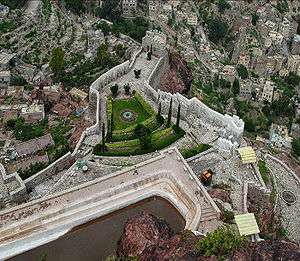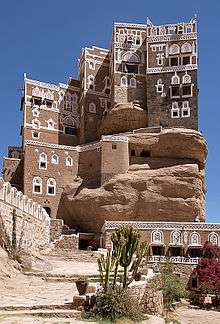Cairo Castle
| Cairo Castle قلعة القاهرة | |
|---|---|
| Taiz, Yemen | |
 Cairo Castle overview, before destruction | |
| Type | hilltop castle |
| Site information | |
| Condition | Reportedly destroyed by airstrikes in 2015[1] |
| Site history | |
| Built |
|
| Built by |
|
Cairo Castle or Al-Qahira Castle is a historical castle in the ancient city of Taiz, Yemen. It is located on the northern slope of Mount Sabr, which is based on rocky highlands overlooking the city. It is said that the area was originally referred as the old Taiz, and later renamed as Al-Qahira (Cairo). The castle is considered as the nucleus of the city of Taiz.[2]
The sultan of the Sulayhids 'Abd Allah ibn Muhammad al-Sulayhi commissioned the castle in the first half of the 12th-century and it was expanded during the rule of his brother Ali ibn Muhammad al-Sulayhi.[3]

Architecture
Cairo Castle consists of two sections. The first section is called "Al-Adina" and includes gardens constructed in the form of terrace built on the slope of the mountain. Water vapor and basins are carved and built in one of the facades of the mountain, as well as the mansions scattered around it surrounded by towers and parks. In this section there are four palaces, each named as Dar al-Adab, Dar al-Shajarah, Dar al-'Adil, and Dar al-'Amara. Dar al-'Amara was specially designated for the sultan and as the guest house for distinguished guests, and it was attached with the tunnels and secret passages connecting to the other palaces. The second part of the castle is referred as "the area of the Maghreb", and consists of a number of palaces, guard towers, grain storage facilities and water reservoirs. The wall of the castle is one of the most important historical artifacts of the city of Taiz, which was built in ancient times in order to contain all the neighborhoods of the old city. It is also believed to have been founded in the era of the Sulayhid dynasty and was built with complex engineering technology. Its height reaches 120 meters and thickness of four meters, and it contained rooms for servants and guardians, some of which still remain today.
As for the castle wall, it connects with the old wall of Taiz, which had four main gates: Bab al-Kabir, Bab Musa, Bab al-Madjar and Bab al-Nasr. Above the gate existed a watch tower guarding the city. The main entrance to the castle is located on the south side of the Al-Moayad area. It consists of a madrasa built by the Sultan al-Muayyad in 1281, a small dome, a pond and the remains of Sultan Al-Muayyed Park. The madrasa has a small sahn, and the park still stands until today.
Destruction
In 2015, during the course of the Yemeni Civil War, the castle was taken over by Houthi rebels, and struck by an airstrike of the Saudi-led coalitions afterwards. The local outlet stated that the castle was "destroyed", although the level of destruction remains unclear.[1]
According to a UNESCO report, Cairo Castle was damaged in two separate strikes: on May 10 and May 21, 2015. 30% of the castle was damaged in the second strike.[4]
Reference
- 1 2 The world may be ignoring the destruction of cultural treasures in YemenThe Washington Post.
- ↑ تعز .. فرادة المكان وعظمة التاريخp.13
- ↑ تعز .. فرادة المكان وعظمة التاريخ p.11
- ↑ "Al-Qahira Castle". UNESCO. Retrieved 2017-07-31.
| Wikimedia Commons has media related to Cairo Castle. |
